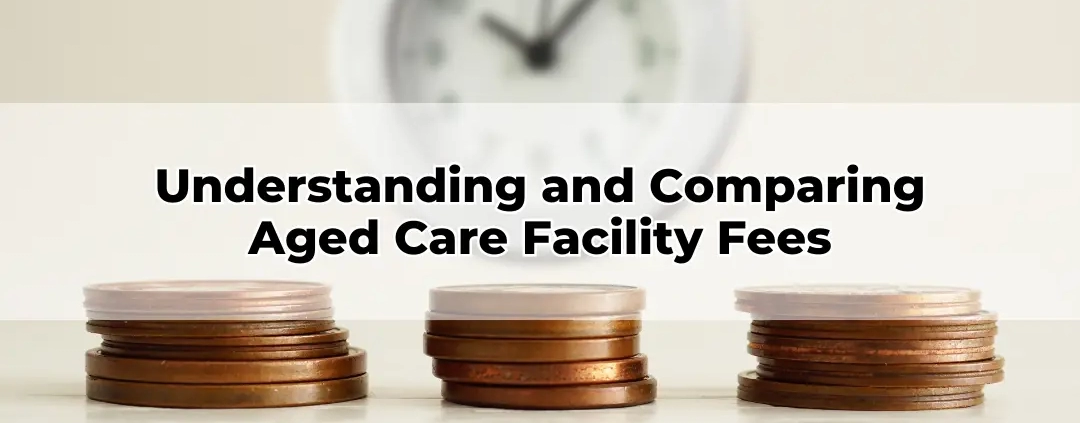Understanding and Comparing Aged Care Facility Fees
Table of Contents
ToggleNavigating the complexities of aged care facility fees can be a daunting task for individuals and families. With multiple fee structures and funding arrangements, understanding the costs associated with aged care is essential for effective financial planning. This bog post provides a comprehensive breakdown of the fees involved in aged care facilities, helping you make informed decisions about the best financial strategy for yourself or a loved one.
The Basic Daily Fee
The basic daily fee is a standard charge that all aged care residents are required to pay. Set by the Australian Government, this fee contributes towards daily living expenses such as meals, laundry, and utilities. As of 2024, the maximum basic daily fee is set at 85% of the single Age Pension. While this fee is universal, it is subject to periodic adjustments in line with pension increases.
Means-Tested Care Fee
A means-tested care fee is an additional charge that applies to individuals with higher financial resources. The amount payable depends on income and assets, assessed through a government-regulated means test. This fee helps fund personal and nursing care services provided in the aged care facility. It is important to note that annual and lifetime caps are in place to limit the total means-tested fees an individual can be required to pay.
Accommodation Payments
Accommodation payments cover the cost of a resident’s room and associated facility services. These payments vary significantly based on location, facility quality, and room type. Residents can choose to pay through a refundable accommodation deposit (RAD), a daily accommodation payment (DAP), or a combination of both. The RAD is a lump sum refundable upon exit, while the DAP is an ongoing payment calculated based on the prevailing government-set interest rate.
Refundable Accommodation Deposit (RAD)
A RAD is a significant upfront payment that secures a resident’s accommodation in an aged care facility. This deposit is fully refundable when the resident leaves or passes away, minus any agreed deductions. The RAD amount varies between facilities and is negotiable, allowing families to explore different financial arrangements based on their liquidity and investment strategies.
Daily Accommodation Payment (DAP): A Flexible Payment Model
For residents who prefer not to pay a large lump sum, the DAP provides a more flexible alternative. This payment is calculated using the government-determined Maximum Permissible Interest Rate (MPIR) and is charged on the unpaid RAD balance. While the DAP allows for greater cash flow retention, it is not refundable, making it crucial to assess long-term affordability.
Extra Services and Additional Fees
Some aged care facilities offer extra service rooms with premium features such as superior accommodation, enhanced dining options, and additional lifestyle amenities. These services incur extra fees, which can be charged as a daily rate or included in the overall accommodation cost. Understanding these fees helps families decide whether the added benefits justify the financial commitment.
Government Funding and Subsidies
Government subsidies are available to help cover the costs of aged care for eligible individuals. The Australian Government provides funding to aged care providers, reducing the amount residents must pay out-of-pocket. Home Care Packages and Commonwealth Home Support Programs can also assist individuals transitioning into aged care, ensuring a smoother financial adjustment.
The Impact of Income and Assets on Aged Care Fees
The financial means test evaluates both income and assets to determine a resident’s contribution towards their care costs. Certain assets, such as the family home, may be assessed differently based on whether a spouse or dependent resides there. Structuring assets efficiently can significantly impact the means-tested care fee and overall financial obligations.
Strategies to Manage Aged Care Costs
Planning ahead is crucial to minimising aged care costs and preserving wealth. Financial strategies such as restructuring assets, gifting within legal limits, and considering financial products like annuities can influence aged care expenses. Engaging an accredited aged care financial adviser ensures that strategies align with regulatory requirements while optimising financial outcomes.
The Role of an Aged Care Financial Adviser
An aged care financial adviser provides expert guidance on navigating aged care fees and structuring finances effectively. With a deep understanding of government policies, means testing, and investment strategies, an adviser can tailor solutions that balance affordability and asset protection. Seeking professional advice early can make a significant difference in long-term financial security.
Conclusion
Understanding aged care facility fees is vital to making informed financial decisions. With multiple cost components, payment options, and government subsidies available, having a clear financial strategy ensures a smoother transition into aged care. Consulting an experienced aged care financial adviser provides clarity and confidence in managing the complexities of aged care funding, helping families secure the best possible care for their loved ones.









